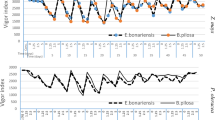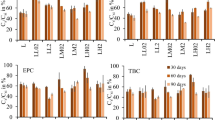Abstract
To protect forest cultures against browsing, chemical repellents can be used. With their applications, however, a problem arises with disruption of biological and chemical equilibria in the environment (e.g., soil-plant system). The aim of this study were to assess possible interactions of repellents, denatonium benzoate (DB), and capsaicin (Cps), with the soil matrix, especially the impact of their addition on the mobility of individual micronutrients and macronutrients, such as calcium, copper, iron, magnesium, manganese, phosphorus, sulfur, and zinc, and to verify the hypothesis that the presence of repellent compounds does not affect the plant-available nutrient concentrations in soil. Batch laboratory soil sorption experiment and the “diffusive gradient in thin films” (DGT) technique were applied to evaluate the elements’ mobility in the soils. Sorption experiment using Chernozem and Fluvisol showed decreased mobile forms of Cu and S with the additions of both repellents and conversely increased mobile forms of Ca and Mn for DB, in both soil types. With increasing Cps rates, the mobile forms of Fe in Chernozem decreased and Mn in Fluvisol increased. The DGT experiment confirmed increased mobile/available Mn in both soils for both repellents and Fe in Fluvisol in the case of capsaicin. Soil application of both, DB and Cps, suggested to be able to influence the elements’ mobility, particularly, Mn mobility in soil significantly increased after repellent application. Their possible behavior in rhizosphere soil/soil solution should be investigated in further research.



Similar content being viewed by others
References
Andersen, F. A. (2008). Final report of the safety assessment of Alcohol Denat., including SD Alcohol 3-A, SD Alcohol 30, SD Alcohol 39, SD Alcohol 39-B, SD Alcohol 39-C, SD Alcohol 40, SD Alcohol 40-B, and SD Alcohol 40-C, and the denaturants, quassin, brucine sulfate/brucine, and denatonium benzoate. International Journal of Toxicology, 27, 1–43. doi:10.1080/10915810802032388.
Antonious, G., & Kochhar, T. (2009). Mobility of heavy metals from soil into hot pepper fruits: a field study. Bulletin of Environmental Contamination and Toxicology, 82(1), 59–63. doi:10.1007/s00128-008-9512-8.
Brasser, S. M., Mozhui, K., & Smith, D. V. (2005). Differential covariation in taste responsiveness to bitter stimuli in rats. Chemical Senses, 30(9), 793–799. doi:10.1093/chemse/bji071.
Cote, S. D., Rooney, T. P., Tremblay, J. P., Dussault, C., & Waller, D. M. (2004). Ecological impacts of deer overabundance. Annual Review of Ecology, Evolution, and Systematics, 35, 113–147. doi:10.1146/annurev.ecolsys.35.021103.105725.
Craven, S. R., & Hygnstrom, S. E. (1994). Deer. In S. E. Hygnstrom, R. M. Timm, & G. E. Larson (Eds.), Prevention and control of wildlife damage (Vol. 2, pp. D-25–D-40). Lincoln: University of Nebraska-Lincoln.
Crosson, G. S., & Sandmann, E. (2013). Kinetic study of denatonium sorption to smectite clay minerals. Environmental Engineering Science, 30(6), 311–316. doi:10.1089/ees.2012.0308.
Crosson, G. S., Thorpe, S., Zhou, Y.-Y., & Dawson, J. (2013). Sorption of denatonium to kaolinite clay from water. Journal of Environmental Protection, 4(9), 929–936. doi:10.4236/jep.2013.49107.
Degryse, F., Smolders, E., Zhang, H., & Davison, W. (2009). Predicting availability of mineral elements to plants with the DGT technique: a review of experimental data and interpretation by modelling. Environmental Chemistry, 6(3), 198–218. doi:10.1071/EN09010.
Fischerová, Z., Száková, J., Pavlíková, D., & Tlustoš, P. (2005). The application of diffusive gradient technique (DGT) for assessment of changes in Cd, Pb, and Zn mobility in rhizosphere. Plant, Soil and Environment, 51(12), 532–538.
Fuller, R. J., & Gill, R. M. A. (2001). Ecological impacts of increasing numbers of deer in British woodland. Forestry, 74(3), 193–199. doi:10.1093/forestry/74.3.193.
Godo, G. H., & Reisenauer, H. M. (1980). Plant effects on soil manganese availability. Soil Science Society of America Journal, 44(5), 993–995.
Hansen, S. R., Janssen, C., & Beasley, V. R. (1993). Denatonium benzoate as a deterrent to ingestion of toxic substances: toxicity and efficacy. Veterinary and Human Toxicology, 35(3), 234–236.
Jakl, M., Jaklová Dytrtová, J., Miholová, D., Kolihová, D., Száková, J., & Tlustoš, P. (2009). Passive diffusion assessment of cadmium and lead accumulation by plants in hydroponic systems. Chemical Speciation and Bioavailability, 21(2), 111–120. doi:10.3184/095422909x456870.
Jakl, M., Jaklová Dytrtová, J., Kunes, I., Baláš, M., Száková, J., & Balík, J. (2014). The long-term effect of slowly dissolved crushed basic rocks amelioration on metals bioavailability in soil. Water, Air, & Soil Pollution, 225(5), 1–9. doi:10.1007/s11270-014-1937-6.
Jakl, M., Jaklová Dytrtová, J., Kuneš, I., & Baláš, M. (2015). Effective concentration of elements in root zone of Norway spruce stand 16 years after fertilization probed with DGT. Water, Air, and Soil Pollution, 226(10), 339. doi:10.1007/s11270-015-2602-4.
Jaklová Dytrtová, J., Šestáková, I., Jakl, M., Száková, J., Miholová, D., & Tlustoš, P. (2008). The use of differential pulse anodic stripping voltammetry and diffusive gradient in thin films for heavy metals speciation in soil solution. Central European Journal of Chemistry, 6(1), 71–79. doi:10.2478/s11532-007-0060-6.
Kabata-Pendias, A. (2011). Trace elements in soils and plants (4th ed.). Boca Raton: CRC Press, Taylor & Francis Group.
Kimball, B., Taylor, J., Perry, K., & Capelli, C. (2009). Deer responses to repellent stimuli. Journal of Chemical Ecology, 35(12), 1461–1470. doi:10.1007/s10886-009-9721-6.
Kuneš, I., Baláš, M., Millerová, K., & Balcar, V. (2011). Introducing of broad-leaved and fir admixture into coniferous stands in the Jizera Mts. (forestry guide no. 231921/2011-MZE-16222/M28). Strnady: CULS Prague, FGMRI.
Lehmkuhler, J. W., Felton, E. E. D., Schmidt, D. A., Bader, K. J., Garrett, H. E., & Kerley, M. S. (2003). Tree protection methods during the silvopastoral-system establishment in midwestern USA: cattle performance and tree damage. Agroforestry Systems, 59(1), 35–42. doi:10.1023/a:1026184902984.
Leverkus, A. B., Castro, J., Puerta-Pinero, C., & Benayas, J. M. R. (2013). Suitability of the management of habitat complexity, acorn burial depth, and a chemical repellent for post-fire reforestation of oaks. Ecological Engineering, 53, 15–22. doi:10.1016/j.ecoleng.2013.01.003.
Mason, J. R., Bean, N. J., Shah, P. S., & Clark, L. (1991). Taxon-specific differences in responsiveness to capsaicin and several analogues: correlates between chemical structure and behavioral aversiveness. Journal of Chemical Ecology, 17(12), 2539–2551. doi:10.1007/bf00994601.
McLaren, R. G., Swift, R. S., & Williams, J. G. (1981). The adsorption of copper by soil materials at low equilibrium solution concentrations. Journal of Soil Science, 32(2), 247–256. doi:10.1111/j.1365-2389.1981.tb01704.x.
Mehlich, A. (1984). Mehlich 3 soil test extractant: a modification of Mehlich 2 extractant. Communications in Soil Science and Plant Analysis, 15(12), 1409–1416.
Mundus, S., Lombi, E., Holm, P. E., Zhang, H., & Husted, S. (2012). Assessing the plant availability of manganese in soils using diffusive gradients in thin films (DGT). Geoderma, 183, 92–99. doi:10.1016/j.geoderma.2012.03.014.
Nolte, D. L. (1998). Efficacy of selected repellents to deter deer browsing on conifer seedlings. International Biodeterioration & Biodegradation, 42(2-3), 101–107. doi:10.1016/s0964-8305(98)00008-0.
Nolte, D. L., Farley, J. P., Campbell, D. L., Epple, G. M., & Mason, J. R. (1993). Potential repellents to prevent mountain beaver damage. Crop Protection, 12(8), 624–626. doi:10.1016/0261-2194(93)90127-5.
Nowack, B., Koehler, S., & Schulin, R. (2004). Use of diffusive gradients in thin films (DGT) in undisturbed field soils. Environmental Science & Technology, 38(4), 1133–1138. doi:10.1021/es034867j.
Pupíková, Z., Száková, J., Sysalová, J., Mestek, O., & Tlustoš, P. (2012). Direct and subsequent effects of contaminated urban particulate matter on risk element mobility and plant-availability in soil. Polish Journal of Environmental Studies, 21(6), 1807–1815.
Puschenreiter, M., Wittstock, F., Friesl-Hanl, W., & Wenzel, W. W. (2013). Predictability of the Zn and Cd phytoextraction efficiency of a Salix smithiana clone by DGT and conventional bioavailability assays. Plant and Soil, 369(1-2), 531–541. doi:10.1007/s11104-013-1597-0.
Reyes-Escogido, M. D., Gonzalez-Mondragon, E. G., & Vazquez-Tzompantzi, E. (2011). Chemical and pharmacological aspects of capsaicin. Molecules, 16(2), 1253–1270. doi:10.3390/molecules16021253.
Richard, S., & Davies, D. C. (2000). Comparison of methyl anthranilate and denatonium benzoate as aversants for learning in chicks. Physiology & Behavior, 70(5), 521–525. doi:10.1016/s0031-9384(00)00298-5.
Sackmann, P., Corley, J. C., Masciocchi, M., & Novas, G. (2010). Effects of the bittering agent denatonium benzoate on the success of toxic baiting of pestiferous German wasps (Vespula germanica). International Journal of Pest Management, 56(1), 69–74. doi:10.1080/09670870903075022.
Saito, A., & Yamamoto, M. (1996). Acute oral toxicity of capsaicin in mice and rats. Journal of Toxicological Sciences, 21(3), 195–200.
Sanders, J. R. (1982). The effect of pH upon the copper and cupric ion concentrations in soil solutions. Journal of Soil Science, 33(4), 679–689.
Santilli, F., Mori, L., & Galardi, L. (2004). Evaluation of three repellents for the prevention of damage to olive seedlings by deer. European Journal of Wildlife Research, 50(2), 85–89. doi:10.1007/s10344-004-0036-1.
Sims, J. T. (1986). Soil pH effects on the distribution and plant availability of manganese, copper, and zinc. Soil Science Society of America Journal, 50(2), 367–373.
Sterner, R. T., & Kimball, B. A. (2005). Slow migration of capsicum oleoresin in a sandy loam soil. International Biodeterioration & Biodegradation, 56(3), 188–191. doi:10.1016/j.ibiod.2005.07.003.
Sterner, R. T., Ames, A. D., & Kimball, B. A. (2002). Persistence of capsicum oleoresin in soil. International Biodeterioration & Biodegradation, 49(2–3), 145–149. doi:10.1016/s0964-8305(01)00115-9.
Surh, Y. J. (2002). Anti-tumor promoting potential of selected spice ingredients with antioxidative and anti-inflammatory activities: a short review. Food and Chemical Toxicology, 40(8), 1091–1097. doi:10.1016/s0278-6915(02)00037-6.
Tixier, H., Maizeret, C., Duncan, P., Bertrand, R., Poirel, C., & Roger, M. (1998). Development of feeding selectivity in roe deer. Behavioural Processes, 43(1), 33–42. doi:10.1016/s0376-6357(97)00084-3.
Tremlová, J., Száková, J., Sysalová, J., & Tlustoš, P. (2013). Bioavailability of arsenic, cadmium, iron and zinc in leafy vegetables amended with urban particulate matter suspension. Journal of the Science of Food and Agriculture, 93(6), 1378–1384. doi:10.1002/jsfa.5903.
Wagner, K. K., & Nolte, D. L. (2001). Comparison of active ingredients and delivery systems in deer repellents. Wildlife Society Bulletin, 29(1), 322–330. doi:10.2307/3784016.
Willoughby, I., Jinks, R., Morgan, G., Pepper, H., Budd, J., & Mayle, B. (2011). The use of repellents to reduce predation of tree seed by wood mice (Apodemus sylvaticus L.) and grey squirrels (Sciurus carolinensis Gmelin). European Journal of Forest Research, 130(4), 601–611. doi:10.1007/s10342-010-0450-8.
Wright, I. A., & Milne, J. A. (1996). Aversion of red deer and roe deer to denatonium benzoate in the diet. Forestry, 69(1), 1–4.
Zhang, H., Davison, W., Knight, B., & McGrath, S. (1998). In situ measurements of solution concentrations and fluxes of trace metals in soils using DGT. Environmental Science & Technology, 32(5), 704–710. doi:10.1021/es9704388.
Acknowledgments
Authors thank Dr. Vlastimil Martinů (ECOLAB Znojmo, spol. s r.o.) for the cooperation. Financial support was provided by the Ministry of Education, Youth and Sports project (S grant).
Author information
Authors and Affiliations
Corresponding author
Rights and permissions
About this article
Cite this article
Jakl, M., Vecková, E. & Száková, J. Repellents Preventing Hoofed Game Browsing Can Alter the Mobility of Nutrients in Soil. Water Air Soil Pollut 227, 399 (2016). https://doi.org/10.1007/s11270-016-3102-x
Received:
Accepted:
Published:
DOI: https://doi.org/10.1007/s11270-016-3102-x




